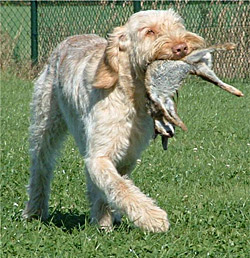| The Spinone, a dog for me, for you, but not for everyone!
|
|
| In those days it hunted down the wild
feather, fixed it (the so called pointing), after which the hunter took in
the wild with net, hawk or falcon. Nowadays the Spinone is an all round
hound, meaning that it also fetches (retrieving to the hunter), but it
will never deny its origins.
Italy is a big country with a wide variety of landscapes, so the Spinone needs to be able to handle all kinds of terrains, like swamps, mountains, forests and meadows. The specific thing about working with the Spinone is its special way of trotting. The Bracco Italiano works in the same way, this contrary to the other standing dogs, who work in gallop. This natural working trot has to be quick and purposeful, has to take
up much space, with the dogs head held high to get the best smell of the
wild. |
|
| The Spinone is a big, robust, solidly built
dog. The height at the withers is 60 to 70 cms for males and 58 to 65 cms
for females. The weight range for males is from 35 to 45 kilos; for
females from 28 and 38 kilos.
Some people think that the dogs are too heavy to do their work, but
because of their natural balance, soundness and inborn hunting instincts
they are pleasant companions. |
 |
| The Spinone is not only big and heavy, it
also stands out because of its coat colour. Mainly that is because of the
white-orange colour, but the brown variety has the same specific breed
characteristics. Its colour, the harsh coat and the different hair on its
head, makes the Spinone a striking appearance.
If you also count with it the absence of black pigmentation and its human expression, which is so desirable according to the standards, it makes it a very attractive dog. The temperament is patient and affectionate. Is the Spinone the perfect dog then? The answer is of course: NO. |
|
| As pups they are naughty and like to
demolish, to trim and to dig a lot. In their early ages they are
persistent in giving their own interpretation of the way they want to live
their lives. They can use their phlegmatic temperament and Ė like other
dogs Ė misuse it of course, and all that with those innocent, sometimes a
bit dumb, expression. But donít be mistaken! If the Spinone decides to do
something its own way, youíre having a hard job convincing the dog to do
it otherwise. The same thing goes for the situation in which the owner
wants the dog NOT to do something. |
 |
| When the owner succeeds in convincing the
Spinone through patience and perseverance, the dog will not forget it. A rough hand will have a contrary effect. An air of consistency with a mix of being patient and ignoring bad behaviour once in a while, will prove more useful. Thatís the reason why we say about this breed, like it is also said
about others of course: |
|
|
Annette Wijnsouw April 2004
|
|
